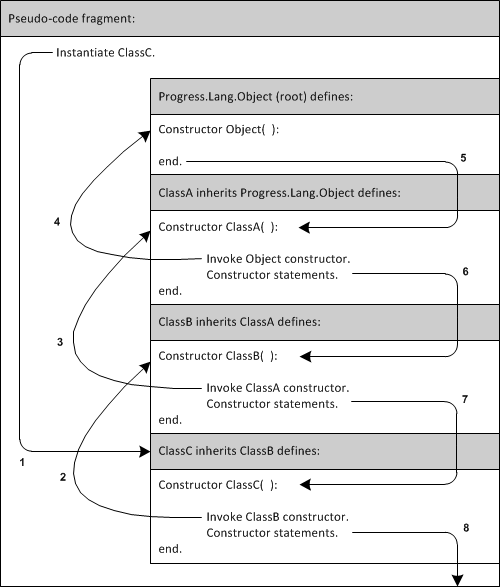One of the great powers of object-oriented programming is inheritance, which facilitates code reuse and polymorphism (see
Polymorphism). The
CLASS construct supports single inheritance of classes. This inheritance allows a class (as a derived class or subclass) to extend another class (its super class). The subclass inherits all the non-private data members, properties, methods, and events of the super class so they appear as if they are part of the subclass. The super class itself might be a derived class that extends its own super class, forming a class hierarchy from the resulting series of super class and subclass relationships. Thus, through this chain of inheritance, a derived class inherits data and behavior from all the super classes in its class hierarchy, including the root class, the super class at the top of the hierarchy. The root class of a hierarchy is the class that does not inherit from any other class. In ABL, the root class of all classes is the built-in, non-abstract class,
Progress.Lang.Object.
The following figure shows the sequence of class construction and inheritance during instantiation of a class hierarchy.
The numbered arrows show the order in which execution occurs during construction of the class hierarchy.
So, an instantiated class (an object) actually represents a hierarchy of classes, with the root class (Progress.Lang.Object) at the top and the instantiated class as the most derived class at the bottom (ClassC). When a class is instantiated, the specified constructor for each class in its class hierarchy is executed as part of the instantiation process. The AVM first invokes the constructor in the instantiated class (ClassC) of the object. The first action of the instantiated class’s constructor must be to invoke a constructor in its immediate super class (ClassB), whether implicitly (for the default constructor) or explicitly (especially if parameters must be passed).
This super class constructor, in turn, invokes a constructor in its own immediate super class (ClassA). This chain of super class constructor invocation continues to the root class (Progress.Lang.Object). When the root class's constructor is invoked, it executes to completion. Execution then returns to its caller, its immediate subclass (ClassA), so that the subclass constructor can complete. This sequence continues until the constructor in the most derived subclass (the originally instantiated class, ClassC) completes. In this way, although instantiation of a class always starts at the bottom of its class hierarchy, the object representing this hierarchy is constructed starting from the root class at the top.
Also, note that one or both of ClassA and ClassB can be either abstract or non-abstract classes. So, in an ABL class hierarchy, only the instantiated class (ClassC in the figure) must be fully implemented (non-abstract).
